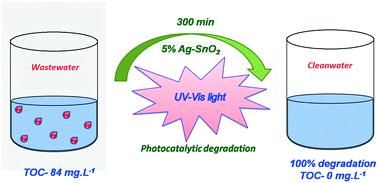当前位置:
X-MOL 学术
›
Environ. Sci.: Water Res. Technol.
›
论文详情
Our official English website, www.x-mol.net, welcomes your
feedback! (Note: you will need to create a separate account there.)
Photodegradation of an ammonium ionic liquid: spiking in urban wastewater and comparison with aromatic ionic liquids
Environmental Science: Water Research & Technology ( IF 3.5 ) Pub Date : 2021-07-20 , DOI: 10.1039/d1ew00245g Sandesh S. Raut 1 , Prashant S. Kulkarni 1
Environmental Science: Water Research & Technology ( IF 3.5 ) Pub Date : 2021-07-20 , DOI: 10.1039/d1ew00245g Sandesh S. Raut 1 , Prashant S. Kulkarni 1
Affiliation

|
Ammonium ionic liquids are being extensively used in several applications, and hence, their effluent treatment is a significant cause of concern. Various Ag-doped SnO2 nanoparticles (2%, 3% and 5% Ag–SnO2) were developed and systematically characterized using advanced analytical instruments. Due to Ag doping in SnO2, the optical bandgap was decreased from the original 3.92 to 3.05 eV. The crystalline NPs showed particle sizes in the range of 40–100 nm. All the synthesized NPs were subjected to degradation of an emerging quaternary ammonium ionic liquid (QAIL) pollutant, Aliquat 336, in the presence of UV-vis light. The sample aliquots were analyzed by a total organic carbon (TOC) analyzer and gas chromatography–mass spectrometry (GC-MS). The 5% Ag–SnO2 catalyst (0.6 g L−1) was able to degrade all the pollutants within 300 min. The essential parameters of photodegradation such as the catalyst concentration, wastewater pH and catalyst recycling were investigated. In a typical study, urban wastewater, which is also an emerging cause of concern, is spiked with the pollutant to evaluate other constituents' effects. It was observed that the proposed photocatalytic methodology could degrade all the pollutants with extended irradiation time. The detailed reaction kinetics with rate constants are presented. For the first time, based on the GC-MS study, the selected QAIL pollutant's degradation pathway is predicted. The original QAIL pollutant was sequentially degraded into CO2 and H2O through the intermediates dioctyl amine, primary amine and pentaldehyde. At the end, the degradation results of QAIL were compared with those of the other reported aromatic ILs.
中文翻译:

铵离子液体的光降解:城市废水中的加标与芳香离子液体的比较
铵离子液体被广泛用于多种应用,因此,它们的废水处理是一个重要的问题。使用先进的分析仪器开发并系统地表征了各种掺杂 Ag 的 SnO 2纳米粒子(2%、3% 和 5% Ag-SnO 2)。由于在 SnO 2 中掺杂 Ag ,光学带隙从原来的 3.92 eV 降低到 3.05 eV。结晶纳米颗粒的粒径范围为 40-100 nm。所有合成的纳米颗粒都在紫外可见光下降解了新出现的季铵离子液体 (QAIL) 污染物 Aliquat 336。通过总有机碳 (TOC) 分析仪和气相色谱-质谱 (GC-MS) 分析样品等分试样。5% Ag-SnO2催化剂(0.6 g L -1)能够在 300 分钟内降解所有污染物。研究了光降解的基本参数,如催化剂浓度、废水 pH 值和催化剂回收。在一项典型的研究中,城市废水(也是一个新出现的问题)与污染物混合以评估其他成分的影响。据观察,所提出的光催化方法可以在延长辐照时间的情况下降解所有污染物。给出了具有速率常数的详细反应动力学。首次基于 GC-MS 研究预测了所选 QAIL 污染物的降解途径。原QAIL污染物依次降解为CO 2和H 2O通过中间体二辛胺、伯胺和戊醛。最后,将QAIL的降解结果与其他报道的芳香ILs的降解结果进行了比较。
更新日期:2021-08-12
中文翻译:

铵离子液体的光降解:城市废水中的加标与芳香离子液体的比较
铵离子液体被广泛用于多种应用,因此,它们的废水处理是一个重要的问题。使用先进的分析仪器开发并系统地表征了各种掺杂 Ag 的 SnO 2纳米粒子(2%、3% 和 5% Ag-SnO 2)。由于在 SnO 2 中掺杂 Ag ,光学带隙从原来的 3.92 eV 降低到 3.05 eV。结晶纳米颗粒的粒径范围为 40-100 nm。所有合成的纳米颗粒都在紫外可见光下降解了新出现的季铵离子液体 (QAIL) 污染物 Aliquat 336。通过总有机碳 (TOC) 分析仪和气相色谱-质谱 (GC-MS) 分析样品等分试样。5% Ag-SnO2催化剂(0.6 g L -1)能够在 300 分钟内降解所有污染物。研究了光降解的基本参数,如催化剂浓度、废水 pH 值和催化剂回收。在一项典型的研究中,城市废水(也是一个新出现的问题)与污染物混合以评估其他成分的影响。据观察,所提出的光催化方法可以在延长辐照时间的情况下降解所有污染物。给出了具有速率常数的详细反应动力学。首次基于 GC-MS 研究预测了所选 QAIL 污染物的降解途径。原QAIL污染物依次降解为CO 2和H 2O通过中间体二辛胺、伯胺和戊醛。最后,将QAIL的降解结果与其他报道的芳香ILs的降解结果进行了比较。











































 京公网安备 11010802027423号
京公网安备 11010802027423号